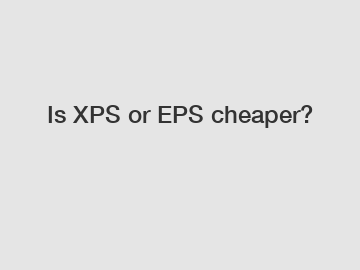Is XPS or EPS cheaper?
Is XPS or EPS cheaper?
When it comes to comparing the cost between XPS (extruded polystyrene) and EPS (expanded polystyrene), it is important to consider various factors to determine which is cheaper. Both XPS and EPS are commonly used as insulation materials, but they differ in their manufacturing processes and properties. In terms of cost, EPS generally tends to be cheaper than XPS due to its simpler manufacturing process and abundance of raw materials.
EPS, which is made by expanding beads of polystyrene, is a lightweight and cost-effective insulation material. The production process involves expanding the beads using steam, which is then molded into various shapes and sizes. This manufacturing method requires less energy and labor, resulting in lower production costs compared to XPS.

On the other hand, XPS is produced by extruding polystyrene through a die, resulting in a more rigid and durable insulation material. The extrusion process involves melting the polystyrene beads with additives and then forcing the mixture through a die to form sheets or boards. This method requires more complex machinery and additional additives, which contribute to higher production costs.
Although XPS tends to be more expensive than EPS, it offers certain advantages that may justify its higher cost. XPS has higher compressive strength and better insulation properties, making it suitable for applications where durability and long-term thermal performance are essential. Additionally, XPS is more resistant to moisture absorption, making it an ideal choice for applications where water exposure is a concern.
The cost difference between XPS and EPS can also depend on market factors and location. In some regions, the availability and demand for XPS may be higher, resulting in a more competitive pricing compared to EPS. Furthermore, the desired specifications and thickness of the insulation can also impact the overall cost. Thicker insulation panels, whether XPS or EPS, will generally incur higher expenses.
The choice between XPS and EPS ultimately depends on several factors, including budget, project requirements, and intended application. If cost is the primary concern and the project does not require specific insulation properties, EPS can be a more economical choice. On the other hand, if durability, higher insulation performance, or moisture resistance is essential, XPS may be the preferred option despite its higher cost.
In conclusion, when comparing the cost between XPS and EPS, it is generally observed that EPS is cheaper due to its simpler manufacturing process and abundance of raw materials. However, the choice between the two insulation materials should consider various factors such as project requirements, intended application, desired performance, and budget.
If you are looking for more details, kindly visit What is the difference between lost foam casting and solid casting, Lost foam casting sand treatment equipment, eps silo.
40
0
0

Comments
All Comments (0)